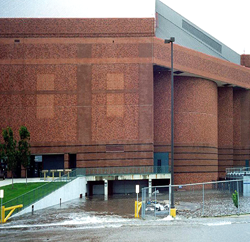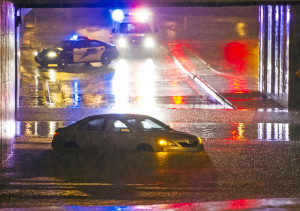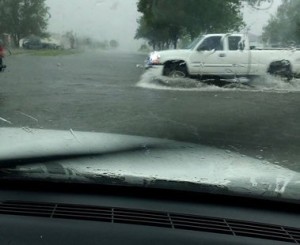
The greatest flood threat facing the Fargo – Moorhead area is not the flood that can be anticipated weeks or even months in advance, which gives residents and local governments time to prepare. It is those flash flood events that catch people off guard, unaware and unprepared, which can be completely disorienting and ultimately overwhelming. Something that the Fargo Diversion Authority has not addressed as PRIORITY #1…, largely because permanent internal flood protection threatens future development and need for the overall Fargo Dam and FM Diversion project.
As a former Fargo and Moorhead resident, I recall several extremely heavy rainfall events that left streets impassible and one specific event occurred in the middle of the night, which sent water rushing into the Trollwood Village Mall complex inundating over 7 businesses including my own. The same storm turned 19th Ave N into a virtual ocean which also flooded the FargoDome.
Whether the F-M metro area spends $1 billion or $5 billion dollars on a dam and diversion, the ever present flood threat tied to heavy rainfall events can erupt with little warning and every passing thunderstorm. So despite the millions and billions spent on “flood control” the areas once thought safe are still at risk of internal flash flooding caused by rain run-off, pooling and storm drain backup.
Last week (August 6, 2015) was a quick reminder of how a localized rainfall event inside the “dry-side” footprint of the Fargo Dam and FM Diversion can easily overwhelm infrastructure.
When storm drains and streets can’t keep up, the false sense of security quickly washes away. There was no “best science” applied, no long term flood forecast tool…, like the models that have missed every flood forecast crest since 1997.
| Monday, March 9th, 2009 Dave Kyner – FEMA Flood Insurance Specialist Insurance News Net One of the big misconceptions about flood insurance, said Dave Kyner, a flood insurance specialist with FEMA, is that “people don’t need flood insurance. That FEMA, if there is a disaster, will come in and take care of us.” “That’s partially true,” Kyner said. “That is, if the president declares the disaster an official one. And then, aside from not-cheap Small Business Administration loans, the only help that might come through FEMA is individual assistance, that tops out at $30,000, he said.” “And $30,000 isn’t much when you take into account that your home is your biggest investment,” Kyner said. “A lot of people had flood insurance in West Fargo but dropped it because of the Sheyenne River Diversion Project,” Kyner said. “They figured they would be safe. But they weren’t safe from the 17 inches of rain that came down. My point is it floods everywhere. A 60-foot dike can’t protect you if it rains 17 inches on the wrong side of the dike.” |
The areas south of I-94 and especially south of 32nd Ave S are natural flood plains that once housed thousands of acre feet of water, now displaced into the Red River creating a higher flood risk for the entire city. The entire flood plain in and around Davies H.S. attenuated flooding in 1969, 1997 and 2009. Those areas are gone…, and continued encroachment is diminishing the efficacy of the remaining vital flood plain every construction season.
So all the hype and tax dollars being poured into the Fargo Dam and FM Diversion project do not address the threat of rainfall induced internal flooding. According to FEMA (cited source: FEMA – ND policies), as of May 31, 2015 there were 12,928 in-force policies in North Dakota, with 5,267 of those located in the Fargo, ND metro area.
Imagine that…, nearly 41 percent of all in-force FEMA policies exist in the Fargo area and “flooded basements” generally occur as a result of heavy rainfall events like those that occurred in July and last week. Ironically, FEMA is working hard to abolish the basement exemption to reduce their exposure risk.
So what rational incentive exists that would compel FEMA to remove flood insurance requirements if or when the overall dam and diversion project is constructed when it fails to address the very flood events that catch people off-guard which also occur with greater frequency?
So where does that leave Fargo residents?
- • on the hook for flood insurance
- • on the hook for county diversion sale tax
- • on the hook for city diversion sale tax
- • on the hook for diversion related tax assessments
- • on the hook for city indirect benefits
- • on the hood for county indirect benefits
- • on the hook for the federal share
Wouldn’t it make more sense to reduce encroachment into the last natural flood plain, complete internal flood-walls dike and levees and provide better storm drains and pumps for the residents currently at risk?
Views: 159


The reason the Fargo Dome and other areas of town flooded several years ago was a direct result of a dam that the city of Fargo decided to build up on county rd. 20 unbeknownst to anyone. Of course it failed to work properly and they were quick to remove any evidence before anyone could figure it out!